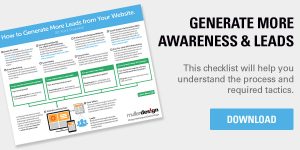
Your website is your most important digital marketing asset. So it’s important to keep it fresh, engaging and differentiated from your competitors. Here are some ideas to inject some life into your site.
Start with a Plan
Just as you would never build a house without a blueprint, the same goes for a website. Make sure you’ve asked and answered the following questions:
• What are our goals for the website?
• Who are our users (personas)?
• What information do they need?
• What are our goals for each persona?
• What content & functionality is required to meet these goals?
• What’s our budget and timeline?
Your plan should also include a requirements list (what you need your site to do) and a sitemap (list of pages).
Identify Your Personas
As with all marketing activities, one should consider who the target audience (persona) is. A persona is a detailed profile of your ideal customer including their demographics, problems, issues, needs, etc.
Many companies make the mistake of building a company-centric website—It’s all about them—their products and services, their story, their history, their team, and so on. Remember, your users have problems they’re trying to solve, so you need to understand what they are, and provide the solutions. A persona helps you focus your site content around the needs of your customer so you can build a user-centric website.
Strengthen Your Brand Positioning
Positioning is what comes to mind when a prospect thinks about your company. One of the biggest benefits of strong positioning is differentiation from your competitors. Positioning can also help a decision-maker choose your company over a competitor. A good place to start when evaluating your positioning is to ask this question: “Why should a potential customer choose you rather than your competitors?” The answer to that question is the foundation of your positioning.
Custom Design
Have you noticed that many sites look the same? Web design has become homogenized by the introduction of low-cost prefabricated templates. One of your main objectives should be to stand out from the crowd—to differentiate from your competitors. One way to do this is with a custom design. It may cost a little more upfront, but considering that your website redesign should last at least five years, amortizing the cost difference is minimal.
Optimize for Search Engines
Your site structure and content should be optimized for search. The higher your site is positioned in the search results, the more traffic you will drive to your site. First, Identify which keywords your personas use and create corresponding content and landing pages for each keyword phrase. Pages should address users’ needs and provide solutions. Keep pages updated and make sure to add keywords to page titles, page URLs, meta description and page copy. As you create and share relevant and quality content, others will link to it. These inbound links are a very important factor in Google’s search algorithm.
Include a Blog
Blog articles allow you to showcase your expertise on various topics, while also helping your site rank higher in the search engines. According to HubSpot, organizations that blog have on average 55% more website visitors and 125% more leads than those who do not. For ideas on what to write about, refer back to your personas’ needs, issues and challenges. You can also broadcast your blog articles on social media for even more exposure.
Optimize for Mobile
Since over 80% of site visits are performed by mobile devices, it’s imperative that your site is mobile-friendly and loads quickly. If not, you’ll lose potential customers. Take a look at your site on your mobile phone. How does it look? Is it responsive and easy to navigate? Does it load quickly? Is there too much content? Mobile users tend to be more fickle than desktop and laptop users. You can filter your site analytics for mobile users, so you can see if there are any issues; such as high bounce rates, low time on page, and low pages per session.
Utilize the Power of Storytelling
Stories are powerful because they’re memorable, they tap into our emotions, and they teach us valuable lessons and timeless truths. Tell your company’s story through your customers’ positive experiences with your products and services. A great format to tell stories is video—especially for mobile users.
Use High Quality Images, Photos and Videos
Photos can make or break your site. Hire a professional photographer to take photos of your products, facilities, people, etc. If you’re using computer-generated imagery (such as CAD models) make sure the resolution is high enough so images look crisp on high definition screens. Most users prefer to view videos rather than reading lots of text so make sure to include product videos, testimonials and stories about your customers using your products and services.
Create Lead Generation Content
How many leads is your website currently generating? In most cases, you can increase this number by simply offering compelling and relevant content that prospects can download in exchange for their name and email address. This tactic has been around for years and is still effective if you can provide useful content such as research, troubleshooting guides, checklists, calculators, product demos, or other content that helps your target persona solve a problem.
If you have any questions or need assistance with your marketing strategy or website, feel free to contact us for a free consultation.

